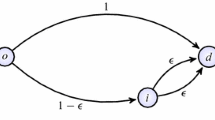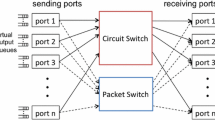Abstract
We investigate a loss circuit switched communication network with state-dependent dynamic routing strategy, wherein the state of the network at the time of call arrival determines whether or not the call is accepted and, if accepted, its route. We develop an approximate approach to the network performance analysis. The approach enhances the Fixed Point Model by treating multiple solutions of the Fixed Point Equations. Assuming that the multiple solutions correspond to the long-living network modes, we develop the aggregated Markov chain that describes the network transitions among these modes. We also propose and discuss a new state-dependent dynamic routing strategy which we call Least-Expected-Blocking strategy (LEB). LEB accepts an incoming call only if this results in a decrease in the expected blocking probability and it chooses a route that yields the maximum decrease. The new strategy outperforms the previously known strategies by the criterion of network steady blocking probability.
Similar content being viewed by others
References
J.M. Akenpelu, The overload performance of engineered networks with nonhierarchical and hierarchical routing, AT&T Bell Labs. Tech. J. 63 (1984) 1261–1281.
G.R. Ash, Use of a trunk status map for real-time DNHR,ITC 11, Kyoto (1985).
G.R. Ash, J.S. Chen, A.E. Frey and B.D. Huang, Real-time network routing in a dynamic class-of-service network,ITC 13, Copenhagen (1991).
W.H. Cameron, J. Regnier, P. Galloy and A.M. Savoie, Dynamic routing for intercity telephone network,ITC 10, Montreal (1983) Paper 3.2–3.
D. Dobrushin and Yu.M. Sukhov, Asymptotic investigation of star message-switching networks with large number of radial rays, Probl. Peredachi Inf. 12 (1976) 70–94.
A.F. Fillipov, Differential equations with a discontinuous right side, Mat. Sb. 51 (1960) 99–128.
R.J. Gibbens, Dynamic routing in circuit-switched networks: The dynamic alternative routing strategy, Ph.D Thesis, University of Cambridge (1988).
R.J. Gibbens, F.P. Kelly and P.B. Key, Dynamic alternative routing —modeling and behavior,ITC 12, Torino (1988) Paper 3.4A.3.
A. Girard and M.A. Bell, Blocking evaluation for networks with residual capacity adaptive routing, IEEE Trans. Commun. COM-37 (1989) 1372–1380.
M. Kac,Probability and Related Topics in Physical Sciences, American Mathematical Society (Interscience, New York, 1959).
R.J. Gibbens and F.P. Kelly, Dynamic routing in fully connected networks, IMA J. Math. Contr.Inf. 7(1990) 77–111.
S. Katz, Statistical performance analysis of a switched communication network,ITC 5, New York (1967) pp. 566–575.
F.P. Kelly, Blocking probabilities in large circuit-switched networks, Adv. Appl. Prob. 18 (1986) 473–505.
L. Kleinrock,Communication Nets: Stochastic Message Flow and Delay (Dover, 1972).
K.R. Krishman and T.J. Ott, Forward-looking routing: A new state-dependent routing scheme,ITC 12, Torino (1988) Paper 3.4A.4.
V.G. Lazarev and S.M. Starobinets, The use of dynamic programming for optimization of control in networks of communication of channels, Eng. Cybern. 3 (1977) 107–116.
V. Marbukh, Asymptotic investigation of a complete communications network with a large number of points and bypass routes, Probl. Inf. Transmission 16 (1981) 212–216.
V. Marbukh, Investigation of a fully connected channel switching network with many nodes and alternative routes, Auto. Remote Control 12 (1982) 1601–1608.
V. Marbukh, Fully connected message switching network with a large number of nodes, bypass routes, and a limited number of waiting places at nodes, 21 (1985) 154–161.
V. Marbukh, Phenomenological approach to reduced description of large scale systems. 1. Description of the approach, Auto. Remote Control 6 (1986) 838–844.
V. Marbukh, Phenomenological approach to reduced description of large scale systems. 2. Large channel switching networks, Auto. Remote Control 8 (1986) 1093–1098.
D. Mitra, R.J. Gibbens and B.D. Huang, State-dependent routing on symmetric loss networks with trunk reservations, I, (1990), submitted for publication.
D. Mitra, R.J. Gibbens and B.D. Huang, State-dependent routing on symmetric loss networks with trunk reservations, II: Asymptotics, optimal design (1990), submitted for publication.
D. Mitra, R.J. Gibbens and B.D. Huang, Analysis and optimal design on symmetric loss networks with trunk reservations,ITC 13, Copenhagen (1991).
G. Nicholis and I. Prigogine,Self-Organization in Nonequilibrium Systems (Wiley, New York, 1977).
M. Priori,Design Method for Non-Hierarchical Circuit Switched Networks with Advanced Routing (Wydawnictwa Politechniki Warszawskiej, Warszawa, 1989).
R.L. Stratonovich,Information Theory (Sovetskoe Radio, Moscow, 1975).
A.D. Venttsel and M.I. Freidlin,Fluctuations in Dynamic Systems under Small Random Perturbations (Nauka, Moscow, 1979).
W. Whitt, Blocking when service is required from several facilities simultaneously, AT&T Tech. J. 4 (1985) 1807–1856.
E.W.M. Wong and T.S. Yum, Maximum free circuit routing in circuit-switched networks,Proc. IEEEINFOCOM(IEEE Computer Society Press, 1990) pp. 934–973.
Author information
Authors and Affiliations
Rights and permissions
About this article
Cite this article
Marbukh, V. Loss circuit switched communication network-performance analysis and dynamic routing. Queueing Syst 13, 111–141 (1993). https://doi.org/10.1007/BF01158931
Received:
Revised:
Issue Date:
DOI: https://doi.org/10.1007/BF01158931




